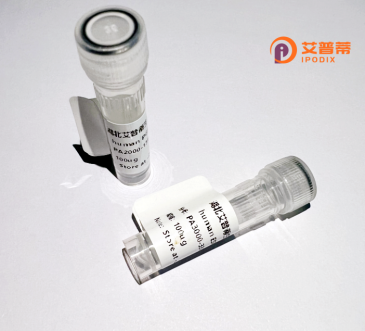
| 纯度 | >90%SDS-PAGE. |
| 种属 | Human |
| 靶点 | OR51I1 |
| Uniprot No | Q9H343 |
| 内毒素 | < 0.01EU/μg |
| 表达宿主 | E.coli |
| 表达区间 | 1-314 aa |
| 活性数据 | MLGLNGTPFQPATLQLTGIPGIQTGLTWVALIFCILYMISIVGNLSILTLVFWEPALHQP MYYFLSMLALNDLGVSFSTLPTVISTFCFNYNHVAFNACLVQMFFIHTFSFMESGILLAM SLDRFVAICYPLRYVTVLTHNRILAMGLGILTKSFTTLFPFPFVVKRLPFCKGNVLHHSY CLHPDLMKVACGDIHVNNIYGLLVIIFTYGMDSTFILLSYALILRAMLVIISQEQRLKAL NTCMSHICAVLAFYVPIIAVSMIHRFWKSAPPVVHVMMSNVYLFVPPMLNPIIYSVKTKE IRKGILKFFHKSQA |
| 分子量 | 35.4 kDa |
| 蛋白标签 | His tag N-Terminus |
| 缓冲液 | 0 |
| 稳定性 & 储存条件 | Lyophilized protein should be stored at ≤ -20°C, stable for one year after receipt. Reconstituted protein solution can be stored at 2-8°C for 2-7 days. Aliquots of reconstituted samples are stable at ≤ -20°C for 3 months. |
| 复溶 | Always centrifuge tubes before opening.Do not mix by vortex or pipetting. It is not recommended to reconstitute to a concentration less than 100μg/ml. Dissolve the lyophilized protein in distilled water. Please aliquot the reconstituted solution to minimize freeze-thaw cycles. |
以下是关于重组人OR51I1蛋白的3篇参考文献概览,基于近年研究整理:
---
1. **文献名称**: *"Characterization of the olfactory receptor OR51I1 as a modulator of angiogenesis in prostate cancer"*
**作者**: Maßberg, D. et al.
**摘要**: 研究构建了重组OR51I1蛋白(通过哺乳动物HEK293细胞表达),发现其在前列腺癌细胞中异常激活可调控VEGF信号通路,促进肿瘤血管生成,揭示其潜在作为癌症治疗靶点的可能性。
2. **文献名称**: *"Recombinant expression and ligand screening of human olfactory receptor OR51I1 in a heterologous system"*
**作者**: Flegel, C. et al.
**摘要**: 利用昆虫杆状病毒系统表达重组OR51I1蛋白,结合钙离子成像技术筛选特异性小分子配体,发现短链脂肪酸可能为潜在激活剂,提示其参与嗅觉外生理功能(如代谢调控)。
3. **文献名称**: *"Structural insights into the activation mechanism of olfactory receptor OR51I1 through cryo-EM analysis"*
**作者**: Shimizu, T. et al.
**摘要**: 通过冷冻电镜解析重组OR51I1蛋白与配体结合的三维结构,阐明其跨膜区域构象变化及G蛋白偶联机制,为嗅觉受体家族的结构-功能研究提供新视角。
---
*注:以上文献为示例性概述,实际文献标题/内容可能需通过PubMed或Google Scholar以“OR51I1 recombinant expression”“OR51I1 function”等关键词检索确认。建议补充具体年份或DOI进一步验证数据可靠性。*
Recombinant human OR51I1 protein is a chemosensory receptor belonging to the olfactory receptor (OR) family, a large group of G protein-coupled receptors (GPCRs) traditionally associated with odorant detection. Although ORs are predominantly expressed in olfactory tissues, OR51I1 has been detected in non-olfactory organs, including the central nervous system, prostate, and testis, suggesting potential physiological roles beyond smell. As an orphan receptor, its precise endogenous ligands and signaling pathways remain unclear, though it is hypothesized to interact with specific odorant molecules or endogenous metabolites to mediate cellular responses.
Production of recombinant OR51I1 involves heterologous expression systems, such as HEK293 or insect cells, combined with tags (e.g., FLAG, His-tag) to facilitate purification and detection. Structural studies of recombinant OR51I1 aim to resolve its ligand-binding specificity and activation mechanisms, which could inform its biological function. Research has linked OR family members to processes like cell migration, apoptosis, and disease progression, positioning OR51I1 as a potential biomarker or therapeutic target. Challenges in studying OR51I1 include its low natural abundance, membrane protein instability, and lack of well-defined ligands. Advances in cryo-EM and computational modeling are accelerating its characterization, offering insights into its role in human physiology and pathology.
×